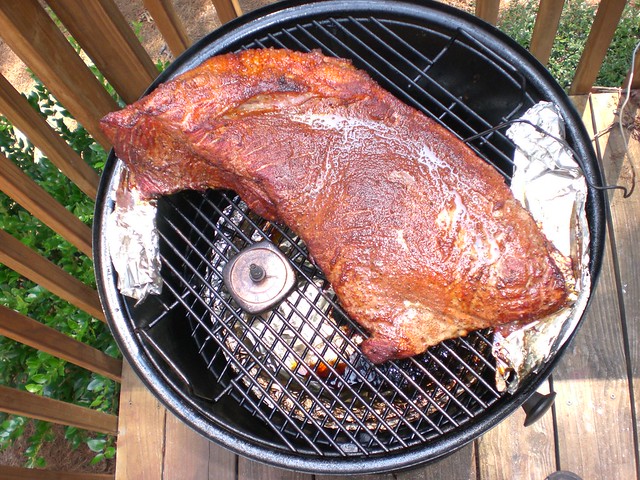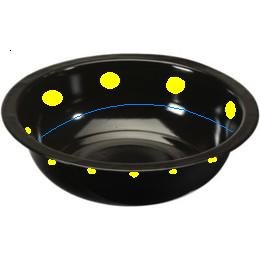Here's my 5-second MS-Paint mock up of an idea using the Brinkman water pan, where the yellow circles represent holes drilled in the top of the bowl walls, and the blue line represents the fill line for the water. I figure that the lip of the bowl will act as just enough of a deflector to help displace some (not all) of the rising heat towards the middle of the cooker before it moves past the water pan.
I don't know how effective this would be, but I can see how you'd get substantial fat in the fire and smoke from burnt drippings on the bottom of the pan.
I wouldn't worry too much about the hot zone around the outside of the grate, except for ribs or briskets. Nowadays, I'll either smoke half slabs in racks or roll and skewer. Two or three inches of foil under the flat end of the brisket will help there.
Use the hot zone to your advantage when it comes to chicken. For instance, always turn chicken where you'll get the thigh done before drying out the other part. If cooking leg quarters, seperate lefties from righties for the two grates and by laying the drum stick knuckles at the center of the grate you'll get more on the racks with the thighs pointed toward the hot zone. (Call it "chicken leg spokes".) I've used three racks for twenty pounds of leg quarters like this and you won't believe how evenly it all gets done, at least if you use some water in the pan and cook 250-275*. For butterflied fryers, cook two to a rack facing opposite directions with the breasts practically touching. As long as the ones on the bottom rack are no larger than about 3.5lbs, you shouldn't have any issues with the drumsticks overcooking if you push the legs up on the breast.
Regarding butts and the hot zone though, check this out: if you take two butts and center them on seperate racks you'll have a harder time getting them done as quickly (and use more charcoal in the process) than if putting two on the top grate. I've cooked many two to a rack and have only just recently started rotating 180* for more evenness. Lots of folks will tell you rotating isn't necessary though, especially if we're talking the top grate. I'd really recommend it though if cooking HH two to a rack or if cooking over 250* with water in the pan.
As to trying to even out temps though, I applaud you. I think you'll find that it's not that big a deal though if you just deal with it as the cook dictates. For instance, put two big butts on the bottom rack and if you lay your brisket on the top rack right, the hot zone is no longer an issue for your brisket ends since the butts will redirect the heat.
The only thing I find that the 18.5" wsm really comes up short on is cooking ribs, and I recently tried putting an entire ring of foil around the perimeter just below the top grate, while cooking three slabs in a rack. Lets just say that I only made things worse, and would only put some foil under the ends if cooking whole slabs...just like protecting the end of a brisket flat.


